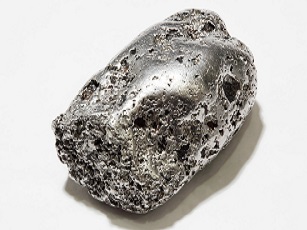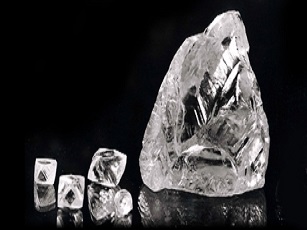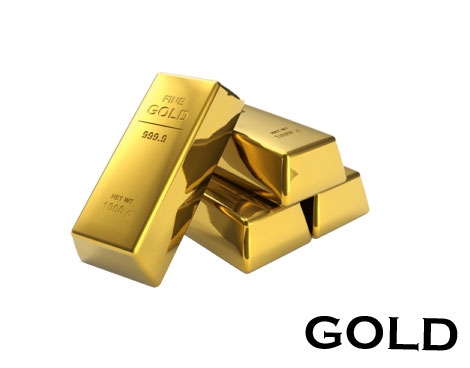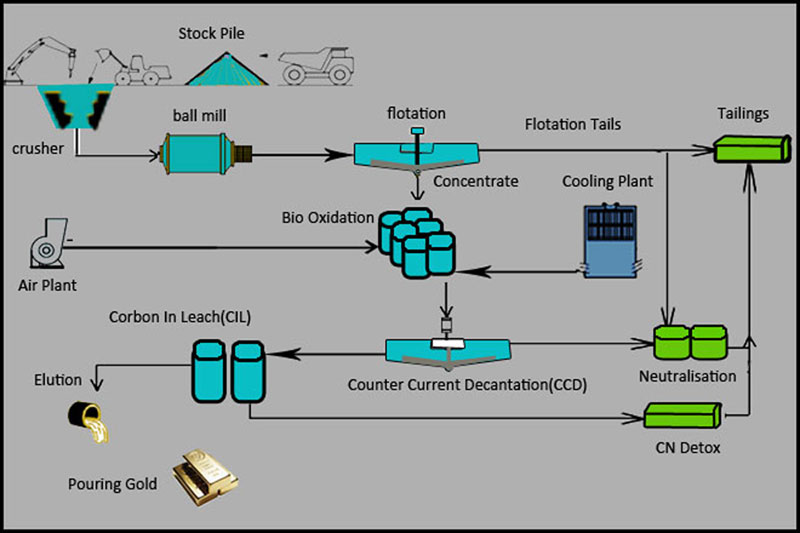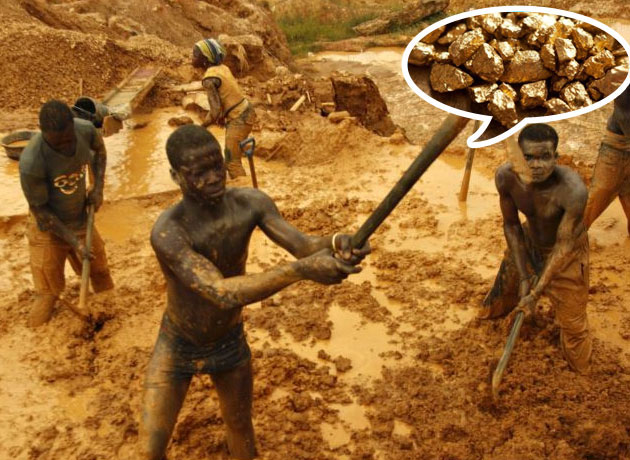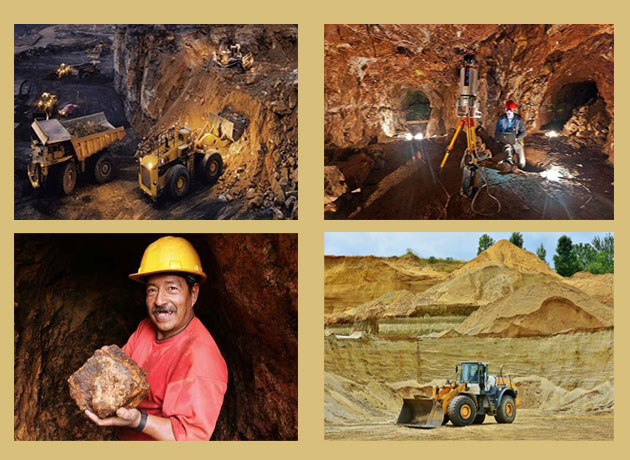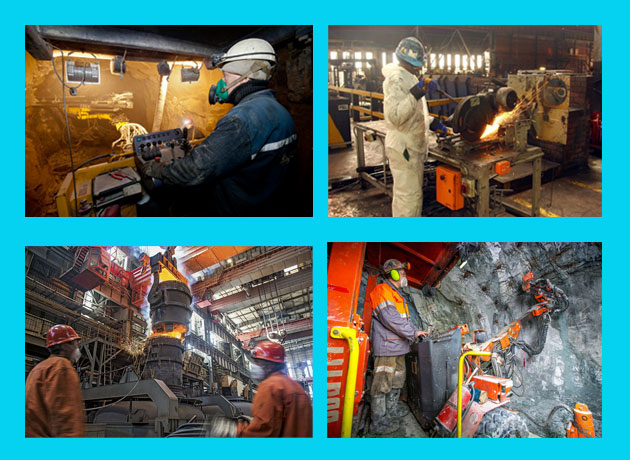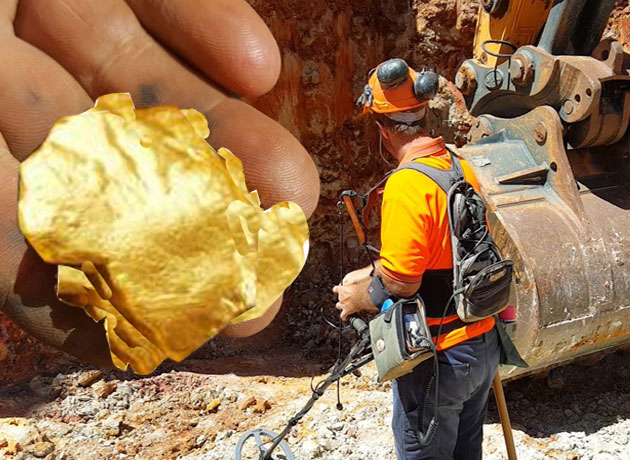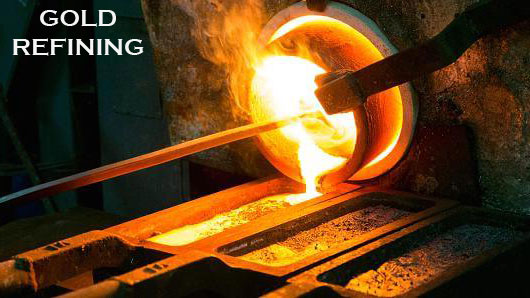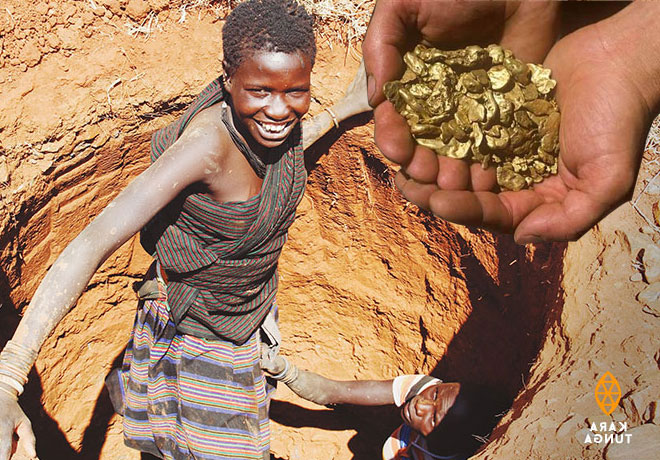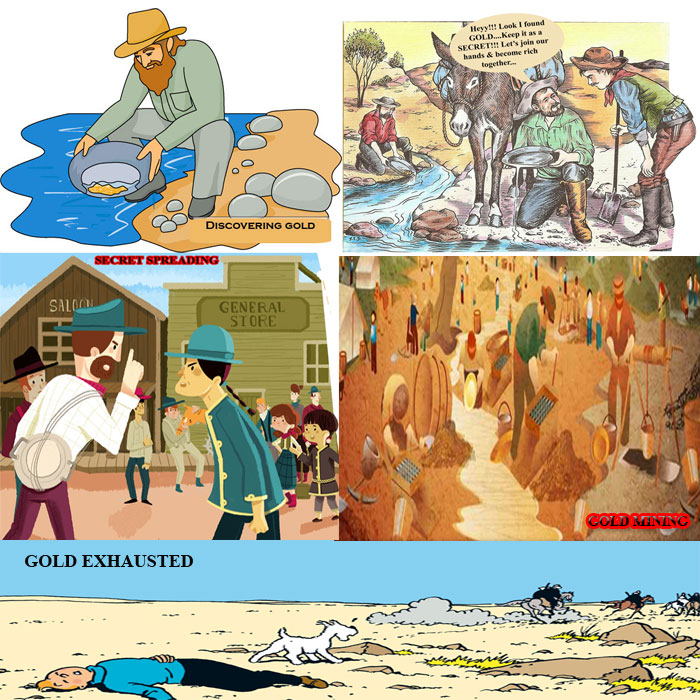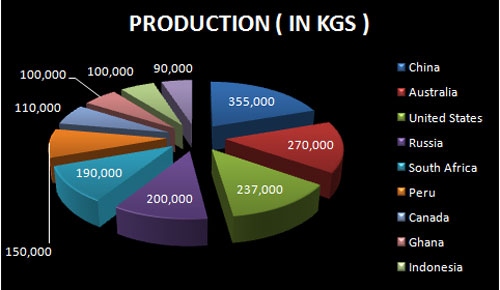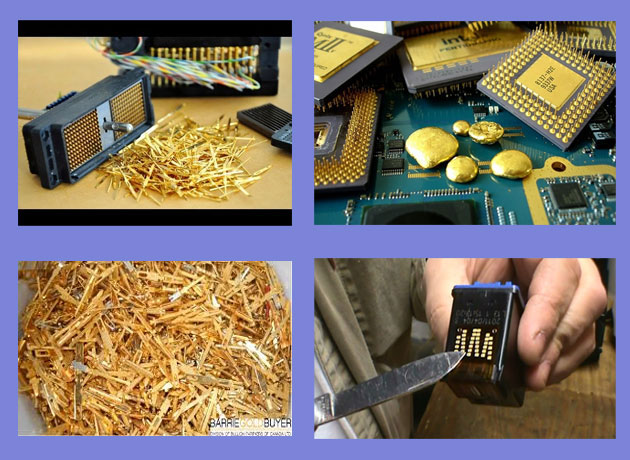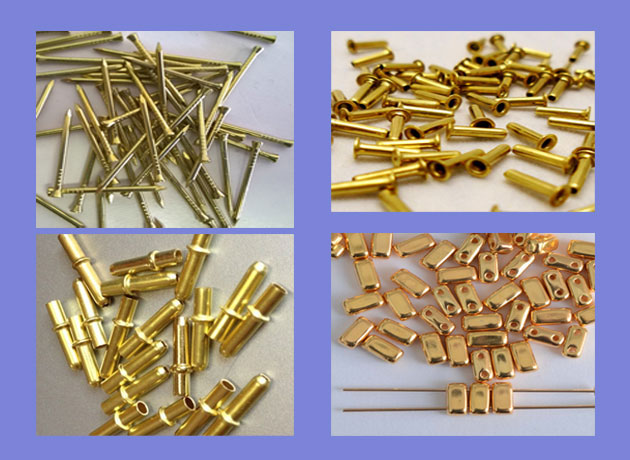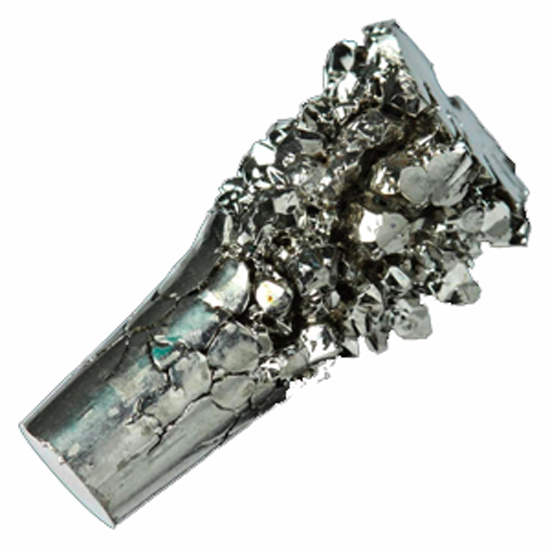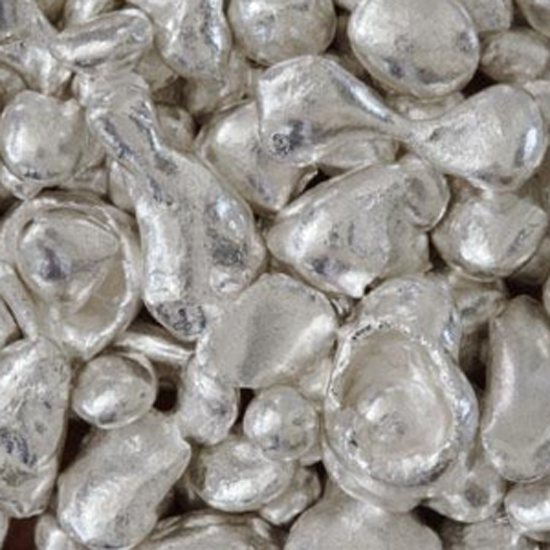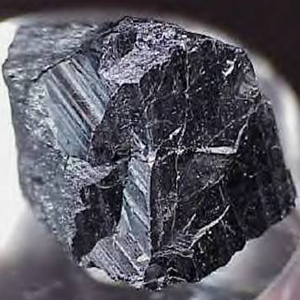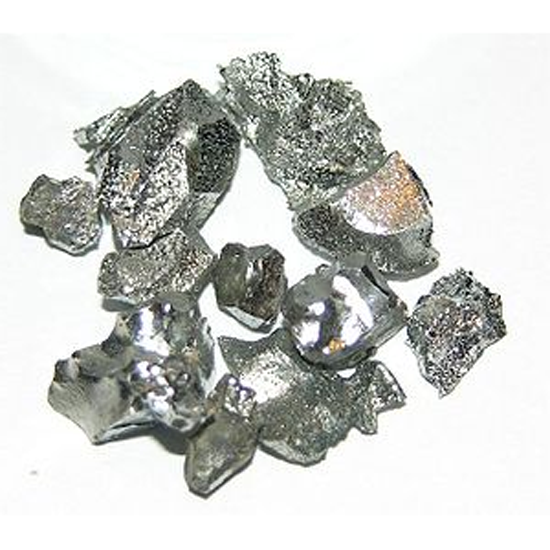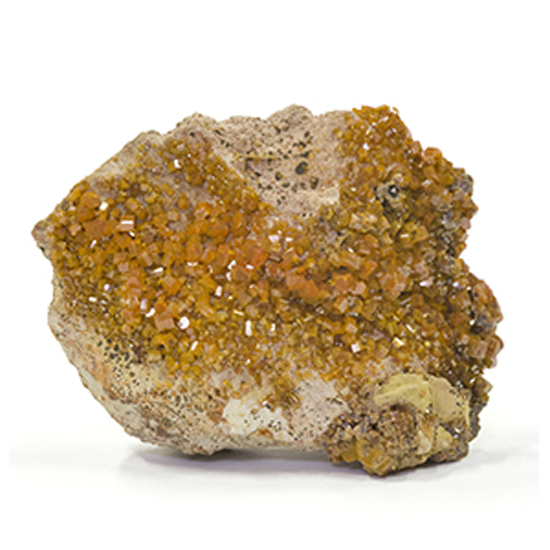GOLD MINING
DESCRIPTION :
Gold is a chemical element with the symbol Au that originates from the Latin derivative "aurum," which means shining dawn, and has the atomic number 79. It is a highly sought-after valuable metal that has been used as wealth for many centuries. The metal appears as nuggets or grain-like structures in rocks, subversive "veins," and in alluvial deposits. It is one of the currency metals. Gold is solid, malleable, glossy, and the most ductile and malleable of all known metals. Chemically, gold exhibits trivalent and univalent transition metal characteristics. Gold does not react with most chemicals but is corroded by chlorine, fluorine, aqua regia, and cyanide. Gold is the most ductile and malleable metal.
* GOLD MINING IN THE UNITED STATES
HOW DOES GOLD FORM ?
The most common natural method of gold concentration occurs through the ancient action of hot fluid within the Earth's crust. Deep fluids are heated by the Earth's internal heat and, as they ascend towards the surface, they gradually cool. These fluids traverse through rocks across extensive areas, dissolving gold along the way. When these fluids encounter cooler conditions or interact with other rock formations, the dissolved gold precipitates within cracks or fractures, forming veins. If this process occurs over a large area and for a prolonged period, gold can accumulate in significant quantities, sometimes reaching parts per thousand or higher.
Additionally, these fluids carry other dissolved minerals, such as quartz, alongside the gold. These formations are termed primary gold deposits. To extract the gold, the rock containing these gold-bearing veins must be mined, crushed, and processed. Over time, the rocks containing gold veins may be exposed on the surface and subjected to erosion. Water further concentrates the gold in these exposed areas.
Due to its weight compared to surrounding materials, gold can become concentrated in depressions and trapped within the riverbeds as the water flows. These concentrations are termed secondary gold deposits.
HOW IS GOLD MINED ?
Gold is extracted through four distinct methods: placer mining, hard rock mining, byproduct mining, and processing gold ore. Each method employs its own set of techniques to extract gold from the surrounding materials.
In placer mining, gold is recovered using methods such as metal detecting, panning, cradling, sluicing, and dredging. This method relies on gravity and water to separate the dense gold from the surrounding materials. Placer mining, an ancient technique, involves the use of water to excavate, transport, concentrate, and recover heavy minerals from alluvial or placer deposits. Examples of deposits mined using this method include gold-bearing sands and gravel that settle out from swiftly moving streams and rivers where the current slows down. Placer mining capitalizes on gold's high density, causing it to sink more rapidly in moving water than lighter siliceous materials found alongside it.
Hard rock mining is the process of using open pit or underground mining tunnels to retrieve gold from the rock. This method of gold mining is responsible for recovering most of the world's gold supply. Miners dig tunnels into solid rock, often risking their health as they dig with picks and shovels during long shifts in these dark, damp tunnels, building shafts, and carting out the ore.
Byproduct mining is related to hard rock mining in that open pit or underground mining tunnels are used. In byproduct mining, gold is a secondary find. The main purpose of the mining operation is the recovery of copper, sand, gravel, or other products, but significant quantities of gold exist to make byproduct mining a profitable venture. An example of this kind of mining would be the Grasberg mine in Papua, Indonesia, which was developed for extracting copper from the earth. Though gold is not the primary product, this mine produces more gold than any other mine in the world.
The final category of gold mining is the processing of gold ore. This method is largely becoming deprecated as the yield of gold is often very low, and the environmental impact and costs of the operation are substantial. The gold ore is finely crushed rock or earth containing trace amounts of gold, which are extracted using a chemical process. The most commonly used chemical for this process is cyanide.
REFINING OF GOLD :
The final stage of gold mining is refining, which involves removing impurities that remain after the smelting process. Refining companies receive gold bars as well as scrap gold and liquefy the metal in a furnace. Workers add borax and soda ash to the molten metal, which separates the pure gold from other precious and less precious metals. A sample is then taken to a lab for tests that measure the gold content. In most cases, the gold is 99.9 percent pure. Workers cast the gold produced during refining into bars. Pure gold is generally too soft for most practical applications, so other metals are nearly always added to it. When gold is combined in this way, it forms an alloy. For example, white gold is made by combining gold with nickel, silver, or palladium. Red or pink gold is an alloy of gold and copper, and blue gold is the result of mixing gold with iron.
Karatage refers to how much gold is present in an object versus another alloy. A higher karatage indicates a higher proportion of gold in the sample. So, 24-karat gold is 100 percent gold, while 12-karat gold has exactly half as much. The common karatages are shown in the accompanying sidebar. For example, the people of India are partial to 22-karat gold, while Europeans prefer 18-karat gold. In the United States, 14-karat gold, which offers a balance between gold content, hardness, and affordability, is by far the most popular.
GOLD MINING IN THE UNITED STATES :
Gold mining in the United States has been ongoing since the discovery of gold at the Reed farm in North Carolina in 1799. The first documented occurrence of gold was in Virginia in 1782, with minor production in North Carolina as early as 1793. The discovery at the Reed farm in 1799, officially identified as gold in 1802 and subsequently mined, marked the beginning of commercial production. Large-scale gold production began with the California Gold Rush in 1848.
GOLD MINING BY STATE :
* Alabama :
Gold was discovered in Alabama around 1830, shortly after the Georgia Gold Rush. The main districts were the Arbacoochee district in Cleburne County, primarily from placer deposits, and the Hog Mountain district in Tallapoosa County, which yielded 24,000 troy ounces (750 kg) from veins.
* Alaska :
Russian explorers discovered placer gold in the Kenai River in 1848, although no gold was initially produced. Gold mining commenced in 1870 from placers southeast of Juneau. From 1880 through the end of 2007, Alaska yielded a total of 40,300,000 troy ounces (1,250,000 kg) of gold. In 2015, Alaskan mines produced 873,984 troy ounces (27,183.9 kg) of gold, contributing approximately 12.7% to the overall US production. The largest gold producer is the Fort Knox mine, a significant open-pit and cyanide leaching operation located in the Fairbanks mining district. In 2015, Fort Knox produced 401,553 troy ounces (12,489.7 kg) of gold. The Pogo mine (283,000 ounces) and Kensington mine (128,865 ounces) gold mines, along with the Greens Creek polymetallic mine (60,566 ounces), accounted for the remaining gold production in 2015.
* Arizona :
The California Gold Rush overshadowed other gold mining endeavors under Spanish and Mexican rule, including those in the Oro Blanco district of Santa Cruz County and the Arivaca district in Pima County. In 1862, mountain man Pauline Weaver discovered placer gold on the east side of the Colorado River, sparking the Colorado River Gold Rush to the now ghost town of La Paz, Arizona, and other locations along the river in the ensuing years. One of the most notable discoveries was that of the San Francisco district, which includes the towns of Oatman, Bullhead City, and Katherine in Mohave County, found in 1863 or 1864. This district yielded 2.0 million ounces of gold through 1959. Additionally, the gold-bearing quartz veins of the Vulture Mine, located southwest of Wickenburg in Maricopa County, were uncovered in 1863, producing 366,000 troy ounces (11,400 kg) of gold through 1959. The Gold Road mine at Oatman, the last gold mine to operate in Arizona, ceased operations in 1998. Currently, Patriot Gold is conducting exploration drilling at the Moss mine at Oatman. In 2006, all of Arizona's gold production was derived as a byproduct of copper mining.
* Colorado :
Gold was initially discovered in 1858 during the Pike's Peak Gold Rush near present-day Denver, but the deposits were limited in size. The first significant gold discoveries in Colorado occurred in the Central City-Idaho Springs district in January 1859. Today, only one Colorado mine remains active in gold production: the Cripple Creek & Victor Gold Mine near Colorado Springs. Owned by Newmont Mining Corporation, this open-pit heap leach operation produced 350,000 troy ounces (11,000 kg) of gold in 2016.
* Florida :
In Northeastern Florida during the late 19th century, small quantities of gold were mined commercially. Records on the exact amount of gold produced are unavailable, but the discovery was insufficient to sustain commercial operations, and the limited pay dirt was exhausted within a few months.
* Georgia :
Georgia boasts a total historical production of 871,000 troy ounces (27,100 kg) of gold from 1830 through 1959. Although historically significant, the state is not currently a gold producer.
* Idaho :
Gold was initially discovered in Idaho in 1860, at the junction of Canal Creek and Orofino Creek in Pierce. The foremost historical gold-producing district is the Boise Basin in Boise County, unearthed in 1862, which yielded 2.9 million troy ounces (90.2 tonnes), mainly from placers. The French Creek-Florence district in Idaho County, originating in the 1860s, has produced about 1 million troy ounces (31 tonnes) from placers. Additionally, the Silver City district in Owyhee County, commencing production in 1863, yielded over 1 million troy ounces (31 tonnes), primarily from lode deposits. The Coeur d'Alene district in Shoshone County, as a byproduct of silver mining, contributed 44,000 troy ounces (1,400 kg) of gold. In 2006, active gold mines in Idaho included the Silver Strand mine and the Bond mine.
* Maryland :
Gold was reported in Maryland as early as 1830, but no production ensued. During the American Civil War in 1861, placer gold was discovered at Great Falls near Washington, DC, by Union soldiers from California. Post-war, several mines were opened on gold-bearing quartz veins in Montgomery County. Total production amounted to about 6,000 troy ounces (190 kg).
* Michigan :
The Ropes gold mine, situated northeast of Ishpeming in Marquette County, Michigan, yielded approximately 29,000 troy ounces (900 kg) of gold. Originally operated underground from 1880 to 1897, the mine was reopened from 1983 to 1989, extracting gold from quartz veins.
* Montana :
Gold was first discovered in Montana in 1852, with mining commencing in 1862 following the discovery of gold placers at Bannack. This sparked a gold rush, leading to further placer discoveries at Virginia City in 1863, and at Helena and Butte in 1864. In 1867, the Atlantic Cable Quartz Lode was located. Although primarily mined for copper, the Butte district produced 2.9 million ounces (91 tonnes) of gold through 1990, mostly as a byproduct of copper production. Current active hardrock gold mines include the Montana Tunnels mine and the Golden Sunlight mine, while active gold placers include the Browns Gulch placer and the Confederate Gulch placer. Additionally, gold is produced from three platinum mines in the Stillwater igneous complex.
* Nevada :
Nevada leads the nation in gold production, with 5,339,659 ounces (166.1 tonnes) produced in 2015, accounting for 78% of US gold and 5.4% of global production. Much of Nevada's gold comes from large open-pit mining and heap leaching recovery methods. Newmont and Barrick operate the largest mining operations in Nevada, particularly on the prolific Carlin Trend, one of the world's richest mining districts.
* New Mexico :
Gold was first discovered in New Mexico in 1828 in the "Old Placers" district in the Ortiz Mountains of Santa Fe County. In 1877, two prospectors stumbled upon float in the vicinity of the future Opportunity Mine near Hillsboro, New Mexico, which was assayed at $160 per ton in gold and silver. Subsequently, ore was found at the nearby Rattlesnake vein, and a placer deposit of gold was uncovered in November at the Rattlesnake and Wicks gulches. Total production prior to 1904 amounted to about $6,750,000.
* North Carolina :
North Carolina witnessed the first gold rush in the United States after 12-year-old Conrad Reed discovered a 17-pound (7.7 kg) gold nugget in a creek on his father's farm in 1799. Gold production occurred in 15 districts, primarily in the Piedmont region of the state. Total gold production is estimated at 1.2 million troy ounces (37.3 tonnes).
* Oregon :
Although gold mines are scattered across Oregon, the majority of the gold produced has originated from two main areas: the Klamath Mountains in southwest Oregon, encompassing Coos, Curry, Douglas, Jackson, and Josephine counties; and the Blue Mountains in northeast Oregon, predominantly in Baker and Grant counties. Placer gold was first discovered by prospectors from Illinois in the Klamath Mountains of southwest Oregon in 1850, initiating a rush to the area. Additionally, lode gold deposits were uncovered. It's said that travelers along the Oregon Trail bound for the Willamette Valley discovered gold in northeastern Oregon in 1845, but significant mining did not commence until 1861.
* Pennsylvania :
About 37,000 troy ounces (1,200 kg) of gold were produced from the Cornwall iron mine, located five miles south of Lebanon in Lebanon County, Pennsylvania. While the deposit had been producing iron since 1742, no gold was reported from the mine until 1878.
* South Carolina :
South Carolina boasted several lode gold mines along the Carolina Slate Belt. The Haile deposit was discovered in Lancaster County in 1827, yielding at least 257,000 troy ounces (8,000 kg) of gold intermittently between then and 1942. After being mined for associated sericite from 1951, the deposit was reopened as an open pit in the 1980s, operating until 1992. Ocean Gold Corp. resumed mining at the Haile deposit in 2016, expecting to produce an average of 126,700 ounces of gold per year for 13.25 years. The Brewer mine, operational from 1828 to 1995, is now a federal Superfund site. Kennecott Minerals operated the Ridgeway open-pit gold mine from 1988 to 1999, with the land now undergoing reclamation by Kennecott. The Barite Hill mine operated from 1990 to 1994.
* South Dakota :
The sole operating gold mine in South Dakota is the Wharf mine, located at Lead, operating as an open-pit heap leach operation under Coeur Mining. In 2016, it produced 109,000 ounces of gold.
* Tennessee :
Placer gold was discovered on Coker Creek in Monroe County, Tennessee, in 1827, with the district yielding approximately 9,000 troy ounces (280 kg) of gold. Additionally, about 15,000 troy ounces (470 kg) of gold were recovered from the massive sulfide copper ores at Ducktown, Tennessee.
* Texas :
Prospecting for gold has been conducted on the Llano Uplift of central Texas, including the Heath mine and the Baby Head district in Llano County, as well as the Central Texas mine in Gillespie County. The extent of gold production, if any, remains unknown. Historically, there have been accounts of the Lost Nigger Gold Mine potentially located in Texas.
* Utah :
Most of Utah's gold production today is a byproduct of the extensive Bingham Canyon copper mine, situated southwest of Salt Lake City. In 2013 alone, the Bingham Canyon mine produced 192,300 troy ounces (5,980 kg) of gold. Over its operational lifetime, Bingham Canyon has yielded more than 23 million ounces (715 tonnes) of gold, ranking among the largest gold producers in the US. The Barneys Canyon mine in Salt Lake County was the last primary gold mine to operate in Utah, contributing to Utah's gold production of 460,000 troy ounces (14,000 kg) in 2006.
* Washington :
Gold was initially discovered in Washington in 1853, primarily as placer deposits in the Yakima Valley. Production remained modest until the mid-1930s, when significant hard rock deposits were developed near the Chelan Lake and Wenatchee deposits in Chelan County, as well as the Republic deposit in Ferry County. Estimated production through 1965 stands at 2.3 million ounces.
* Wyoming :
Gold was unearthed at the South Pass-Atlantic City-Sweetwater district in present Fremont County in 1842. While the placers were intermittently worked until 1867, when the first significant gold vein was discovered, resulting in a rush of prospectors and miners to the area. The towns of South Pass City, Atlantic City, and Miner's Delight catered to the miners during this period. Although the district was largely deserted by 1875, with sporadic activity afterward, total gold production reached approximately 300,000 troy ounces (9,300 kg). In 1962, the district became the site of a major iron mine.
* Moraine gold :
Several states, such as Illinois, Indiana, Ohio, and Pennsylvania, possess placer gold deposits despite lacking hard rock gold deposits. These placer gold deposits are typically found north of or near the terminus of Pleistocene or earlier moraines, left by Ice Age glaciers that transported gold-rich dirt from Canada, where hard rock gold deposits exist. Limited commercial operations have intermittently mined this gold with varying degrees of success. The southernmost limit of these moraines, Pleistocene and older, extends approximately to the Ohio River for Illinois, Indiana, and Ohio, while in Pennsylvania, the moraines are located in the northwestern and northeastern portions of the state.
CALIFORNIA GOLD RUSH :
The California Gold Rush refers to the swift influx of fortune seekers into California, ignited by the discovery of gold at Sutter's Mill in early 1848, which reached its zenith in 1852. It's estimated that over 300,000 individuals migrated to the region during this Gold Rush period.
In 1848, John Sutter was having a water-powered sawmill built along the American River in Coloma, California. On January 24th, his carpenter, James W. Marshall, found flakes of gold in a streambed. Sutter and Marshall agreed to become partners and tried to keep their find a secret. However, the discovery soon spread, and they were surrounded by thousands of fortune seekers. From the East, prospectors sailed around Cape Horn or risked disease hiking across the Isthmus of Panama. By August 1848, 4,000 gold miners were in the area, and within a year, about 80,000 had arrived at the California goldfields. By 1853, their numbers had grown to 250,000. Although it was estimated that some $2 billion in gold was extracted, few of the prospectors struck it rich. The work was hard, prices were high, and living conditions were primitive. The Gold Rush loosened as the most workable deposits were exhausted, and organized capital and machinery replaced the efforts of individual miner-adventurers with more efficient and business-like operations. Likewise, the lawless and violent mining camps gave way to permanent settlements with organized government and law enforcement. Those settlements that lacked other viable economic activities soon became ghost towns after the gold was exhausted. The California Gold Rush peaked in 1852, and by the end of the decade, it was over. The Gold Rush had a profound impact on California, dramatically changing its census. Before the discovery of gold, the territory's population was approximately 160,000, the vast majority of whom were Native Americans. By about 1855, more than 300,000 people had arrived. Most were Americans, though a number of settlers also came from China, Europe, and South America. The massive rush gave rise to numerous cities and towns, with San Francisco gaining particular prominence. The Gold Rush was credited with hastening statehood for California in 1850.
GOLD MINING IN INDIA :
India has long been the top source of global gold demand, importing close to 1,000 tonnes in good years. However, with the closure of the iconic Kolar Gold Field in 2001 after more than 120 years of production, which yielded 800 tonnes or 26 million troy ounces, India now hosts only a single gold mine. The Hutti Gold Mine, situated in the southwestern state of Karnataka, has historical significance, commencing production in 1902 and located in the same greenstone belt as Kolar. Hutti produced approximately 45,000 ounces in 2015, and even with the addition of gold produced as a byproduct of copper mining on the subcontinent, India's gold output barely exceeds 60,000 ounces. Moreover, the rate of production is the lowest since at least 1970.
GOLD MINING IN AUSTRALIA :
Gold mining in Western Australia ranks as the fourth largest commodity sector in the region, following iron ore and crude oil, with a value of A$10 billion. The history of gold mining in Western Australia dates back to the 1880s but burgeoned into a significant industry in the 1890s, spurred by discoveries at Coolgardie in 1892 and Kalgoorlie in 1893. It saw an early peak in 1903, experienced resurgence in the 1930s and again in the 1980s. However, the industry faced decline at various points, notably during the two world wars, reaching a nadir in 1976.
current situation:
In the fiscal year 2015-16, Western Australia accounted for over 50% (equivalent to $69.5 billion) of all Australian mineral and petroleum sales, constituting 88% of the state's merchandise exports. Gold, ranking third in the list of resources exported by Western Australia in terms of value, trailed behind iron ore and petroleum, with a total worth of A$10 billion. The state's gold production amounted to 6.27 million troy ounces or 195 tonnes, representing 6% of global production. Direct employment in the Western Australian gold mining industry stood at 19,175 individuals during the 2014-15 period.
By the fiscal year 2008-09, gold had ascended to the fourth spot in terms of export value, totaling A$5.2 billion, surpassing alumina. The average gold price reached US$874 per ounce or A$1,171 per ounce in 2008-09, marking a 28% increase compared to the previous year. Although the value of sales surged by 25%, the state's gold output experienced a 4% decline, amounting to 4.4 million ounces. Western Australia contributed 62% to Australia's gold production in 2008-09.
The Golden Mile emerged as Western Australia's leading gold-producing mine in 2008-09, yielding 20 tonnes of gold, trailed by the Telfer with 18.1 tonnes and St Ives with 13.4 tonnes. The Boddington Gold Mine, with a project cost of US$2.9 billion, stood out as the largest gold project to commence production in the state in 2009, with a capacity to produce 900,000 ounces of gold annually. Employment in the Western Australian gold mining industry increased to 15,572 individuals in 2008-09.
WORLD PRODUCTION :
USES :
Gold possesses remarkable properties such as extreme malleability, excellent electrical conductivity, resistance to tarnishing, and compatibility with other metals, making it easy to shape into wires or sheets. Additionally, its natural brilliant luster and glossy shine are unparalleled. Due to these unique attributes, gold finds its way into nearly every facet of modern life.
Here are the six most prevalent uses of gold in the world today:
Jewelry :
Approximately 78% of the gold consumed annually is crafted into jewelry. Jewelry serves as the most widespread means through which gold reaches consumers and has been a primary use for the metal across various cultures. With its captivating beauty and enduring qualities, gold jewelry stands as an adornment both celestial and esteemed.
-
Finances and Investing :
Given its rarity and high value, gold naturally serves as a currency. Previously, the U.S. tied its monetary currency to a gold standard. Amidst economic uncertainty, gold has emerged as a potential financial anchor. Holding or investing in gold commonly involves gold coins, gold bars, or gold bullion.
Electronics and Computers :
Gold boasts exceptional conductivity, allowing it to efficiently transmit tiny electrical charges. Consequently, a small quantity of gold is present in nearly all electronic devices, including cell phones, televisions, GPS units, and more. Its effectiveness as a conductor also leads to its use in desktop and laptop computers to facilitate swift data transfer.
Dentistry and Medicine :
Gold serves as the optimal material for fillings, crowns, bridges, and orthodontic appliances due to its chemical inertness, ease of insertion, and non-allergenic properties. Dentistry has utilized gold since 700 B.C. In the medical realm, small quantities of gold isotopes are employed in certain radiation treatments and diagnoses.
Aerospace :
In the aerospace industry, where reliable and efficient technologies are imperative for survival, gold assumes a vital role. It is utilized to lubricate mechanical components, conduct electricity, and coat the interiors of spacecraft to shield occupants from infrared radiation and heat.
Medals and Awards :
As a highly esteemed precious metal, gold naturally features in crowns, awards, and religious statues. From Academy Awards to Olympic medals, gold is renowned for its admirable qualities and holds a permanent place of value in humanity's eyes.
Related Mining

